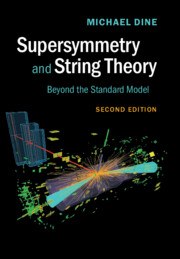Book contents
- Frontmatter
- Dedication
- Contents
- Preface to the First Edition
- Preface to the Second Edition
- A note on the choice of metric
- Text website
- Part 1 Effective field theory: the StandardModel, supersymmetry, unification
- Part 2 Supersymmetry
- 9 Supersymmetry
- 10 A first look at supersymmetry breaking
- 11 The Minimal Supersymmetric Standard Model
- 12 Supersymmetric grand unification
- 13 Supersymmetric dynamics
- 14 Dynamical supersymmetry breaking
- 15 Theories with more than four conserved supercharges
- 16 More supersymmetric dynamics
- 17 An introduction to general relativity
- 18 Cosmology
- 19 Particle astrophysics and inflation
- Part 3 String theory
- Part 4 Appendices
- References
- Index
16 - More supersymmetric dynamics
from Part 2 - Supersymmetry
- Frontmatter
- Dedication
- Contents
- Preface to the First Edition
- Preface to the Second Edition
- A note on the choice of metric
- Text website
- Part 1 Effective field theory: the StandardModel, supersymmetry, unification
- Part 2 Supersymmetry
- 9 Supersymmetry
- 10 A first look at supersymmetry breaking
- 11 The Minimal Supersymmetric Standard Model
- 12 Supersymmetric grand unification
- 13 Supersymmetric dynamics
- 14 Dynamical supersymmetry breaking
- 15 Theories with more than four conserved supercharges
- 16 More supersymmetric dynamics
- 17 An introduction to general relativity
- 18 Cosmology
- 19 Particle astrophysics and inflation
- Part 3 String theory
- Part 4 Appendices
- References
- Index
Summary
While motivated in part by the hopes of building phenomenologically successful models of particle physics, we have uncovered in our study of supersymmetric theories a rich treasure trove of field theory phenomena. Supersymmetry provides powerful constraints on the dynamics. In this chapter we will discover more remarkable features of supersymmetric field theories. We will first study classes of (super)conformally invariant field theories. Then we will turn to the dynamics of supersymmetric QCD with Nf ≥ Nc, where we will encounter new, and rather unfamiliar, types of behavior.
Conformally invariant field theories
In quantum field theory, theories which are classically scale invariant are typically not scale invariant at the quantum level. Quantum chromodynamics is a familiar example. In the absence of quark masses we believe that the theory predicts confinement and has a mass gap. The CPN models are an example where we were able to show systematically how a mass gap can arise in a scale-invariant theory. In all these cases the breaking of scale invariance is associated with the need to impose a cutoff on the high-energy behavior of the theory. In a more Wilsonian language one needs to specify a scale where the theory is defined, and this requirement breaks the scale invariance.
There is, however, a subset of field theories which are indeed scale invariant. We have seen this in the case of N = 4 supersymmetric field theories in four dimensions. In this section we will see that this phenomenon can occur in N = 1 theories and will explore some of its consequences. In the next section we will discuss a set of dualities among N = 1 supersymmetric field theories, in which conformal invariance plays a crucial role.
In order that a theory exhibit conformal invariance it is necessary that its beta function vanish. At first sight it would seem difficult to use perturbation theory to find such theories. For example, one might try to choose the number of flavors and colors in such a that the one-loop beta function vanishes. But then the two-loop beta function will generally not vanish.
- Type
- Chapter
- Information
- Supersymmetry and String TheoryBeyond the Standard Model, pp. 222 - 230Publisher: Cambridge University PressPrint publication year: 2016



